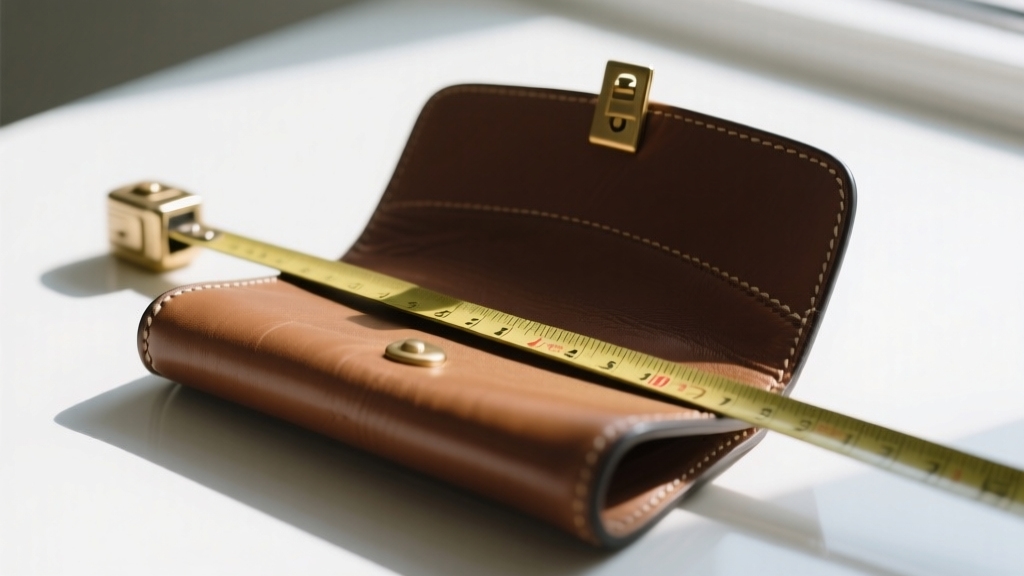
To measure your purse, lay it flat on a surface and use a flexible tape to get its length across the base, ignoring handles. Then, stand it upright to measure height from bottom to top, excluding straps. For width or depth, measure from front to back at the widest point.
Don’t forget strap length—measure from end to end or the drop, where the bag rests on your shoulder. Mastering these basics helps you find the perfect fit and style, and there’s more to explore about precise measurements and fit next.
Key Takeaways
- Measure purse length by laying it flat and using a tape measure across the longest horizontal side at the base.
- Measure height by standing the purse upright and measuring from the bottom hem to the top hem, excluding handles or straps.
- Determine width and depth by measuring the widest points front-to-back and side-to-side, including any protrusions or expansions.
- Measure strap length by laying the strap flat end-to-end, noting shortest and longest lengths if adjustable.
- Use consistent points for measurements and double-check brand definitions to avoid confusion between width and depth.
Understanding Purse Dimensions
Although purse dimensions might seem straightforward, understanding them requires traversing varying standards and terminology that can easily confuse you.
You’ll notice that measurements often include length, height, and width, but brands differ in how they list these; some use length/height/width, others height/width/depth.
Length and width sometimes get swapped, so don’t assume they mean the same thing. It is important to measure height from the base to maintain consistency in sizing. Beyond these, some dimensions also account for the drop of handles or straps, which affects how the purse hangs when carried.
Knowing these measurements isn’t just about numbers; it helps you gauge capacity and style. Understanding the differences in how designers list bag dimensions can prevent confusion when comparing purses.
Measuring the Length of a Purse
Start by laying the purse flat, front facing up, on a level surface. Use a flexible measuring tape to measure the longest horizontal side, the base from left to right, excluding any handles or straps. This measurement represents the longest side of the purse, which is crucial for understanding its overall size.
Keep the tape straight and flat for precision. Repeat if the purse is asymmetrical. Remember, length is the longest front-facing dimension, not the height or depth. For international travelers, it’s important to consider luggage security when transporting purses.
| Step | Action |
|---|---|
| Position | Lay purse flat, front facing up |
| Measure | Tape from left edge to right edge |
| Record & Confirm | Write down measurement, repeat |
How to Measure Purse Height Accurately?
When you measure a purse’s height, focus on capturing the vertical distance from the bottom hem to the top hem along the center of the front.
Place your purse upright on a flat surface, keeping it unfilled so it maintains its natural shape. The durability of leather can affect how the purse holds its shape over time, making this step important for accurate measurement.
Use a flexible measuring tape to follow the purse’s contours accurately, making sure the tape runs straight, not slanted, along the midpoint rather than edges.
Use a flexible tape measure along the purse’s center, ensuring it’s straight and not angled for accuracy.
Exclude handles, straps, or any extensions from this measurement. For irregularly shaped bags, measure from the lowest to the highest point of the main body, avoiding flaps or hinged openings.
Precise height measurement is vital. It helps you understand the vertical space inside and ensures your purse fits your style and storage needs perfectly, especially when shopping online or comparing designer pieces.
Always remember to measure the interior dimensions of the bag to ensure the most accurate fit for accessories or organizers.
Determining the Width or Depth of Your Purse
Now that you’ve mastered measuring your purse’s height, turning your attention to width and depth will give you a fuller picture of its size and capacity. Width typically refers to the side-to-side measurement across the base, while depth captures the front-to-back dimension.
To get accurate readings, lay your purse flat on a level surface and place a flexible tape measure taut along the base, avoiding straps or handles. Using a flexible tape measure ensures precision in your measurements. It’s important to include any protruding parts, such as handles or decorative elements, to capture the full luggage dimensions.
Focus on the widest points, especially if your bag expands when filled, to understand real-world storage space. Since designers sometimes swap width and depth labels, double-check product details to avoid confusion.
Accurate width and depth measurements help you gauge what fits inside and ensure you pick a purse that suits your lifestyle and style trends perfectly.
Measuring Strap and Drop Length for Comfortable Fit
Although strap length might seem straightforward, measuring it accurately is essential for ensuring your purse fits comfortably and complements your style. Start by laying the strap flat and measuring from end to end, noting both shortest and longest lengths if adjustable.
Lay the strap flat and measure from end to end, noting shortest and longest lengths if adjustable.
Next, determine the drop length: the distance from your shoulder to where the bag rests, since it directly affects comfort and accessibility. Considering surface compatibility can also influence how the purse hangs and moves with you.
For most, a drop of 18 to 23 inches works well, but crossbody bags often need 26 to 30 inches. Consider your height and body shape: taller frames usually require longer straps, while petite sizes benefit from shorter drops to avoid the bag hanging too low.
Using a string to simulate the strap length can help you fine-tune the fit before finalizing your measurement. Adjustable straps provide versatility to customize the length based on your personal comfort and outfit choices.
Frequently Asked Questions
How Do I Measure a Purse’s Interior Capacity or Volume?
To measure your purse’s interior capacity, start by using a flexible tape to capture its length, height, and depth at the widest points inside. Multiply these three measurements to get the volume in cubic inches, then divide by 61 to convert to liters.
Keep in mind, irregular shapes or pockets reduce usable space, so this is an estimate. This method helps you compare bags smartly and stay stylishly organized on the go.
What Tools Are Best for Measuring Curved or Soft Purses?
You’ll want flexible tape measures and multi-radius rulers to tackle curved or soft purses with ease. These tools adapt to shapes, giving you precise measurements without distortion.
Digital measuring devices add accuracy by rolling smoothly along curves, while clear acrylic rulers help you see fabric alignment clearly. Prioritize tools that combine flexibility, durability, and versatility. This way, you’ll nail perfect fits and professional-looking designs every time.
How Does Purse Material Affect Measurement Accuracy?
Purse material plays a huge role in measurement accuracy because flexible fabrics can stretch or compress, skewing your numbers.
If you’re measuring leather, expect some stiffness and creases that might affect the shape.
Padded or layered materials add bulk, so you’ll need to adjust for that.
Using a flexible tape and measuring a filled purse helps you capture the true size, ensuring your measurements are spot-on despite material quirks.
Should I Measure My Purse When It’s Empty or Full?
You should definitely measure your purse empty. Imagine trying to squeeze a stuffed suitcase into a tiny overhead bin! Measuring empty gives you the true size without bulges or weird shapes. It’s the gold standard for designers and shoppers alike.
If you want to see how much it holds, measure full separately. But for accuracy and style comparisons, empty measurements keep things sleek, precise, and totally on-trend.
How to Measure Expandable or Adjustable Gusset Dimensions?
To measure expandable or adjustable gussets, gently flatten your purse without stretching it. Open the gusset fully to capture its maximum depth.
Measure from the outer fold edge to the inner crease for one side only, avoiding doubling unless calculating total expandable width. Record your dimensions as Width × Gusset Depth × Height, keeping it precise and clear.
This method guarantees you capture the purse’s true expandable capacity with style and accuracy.
Shop Smart: Choose a Purse That Looks Good and Feels Right
Now that you know how to measure every angle of your purse, aren’t you excited to find that perfect fit that complements your style effortlessly? From length to strap drop, each measurement guarantees your bag isn’t just trendy but comfortable and functional too.
Measuring your purse accurately helps you stay ahead in fashion while keeping practicality in check. A well-measured purse isn’t just an accessory; it’s a statement piece tailored just for you.
